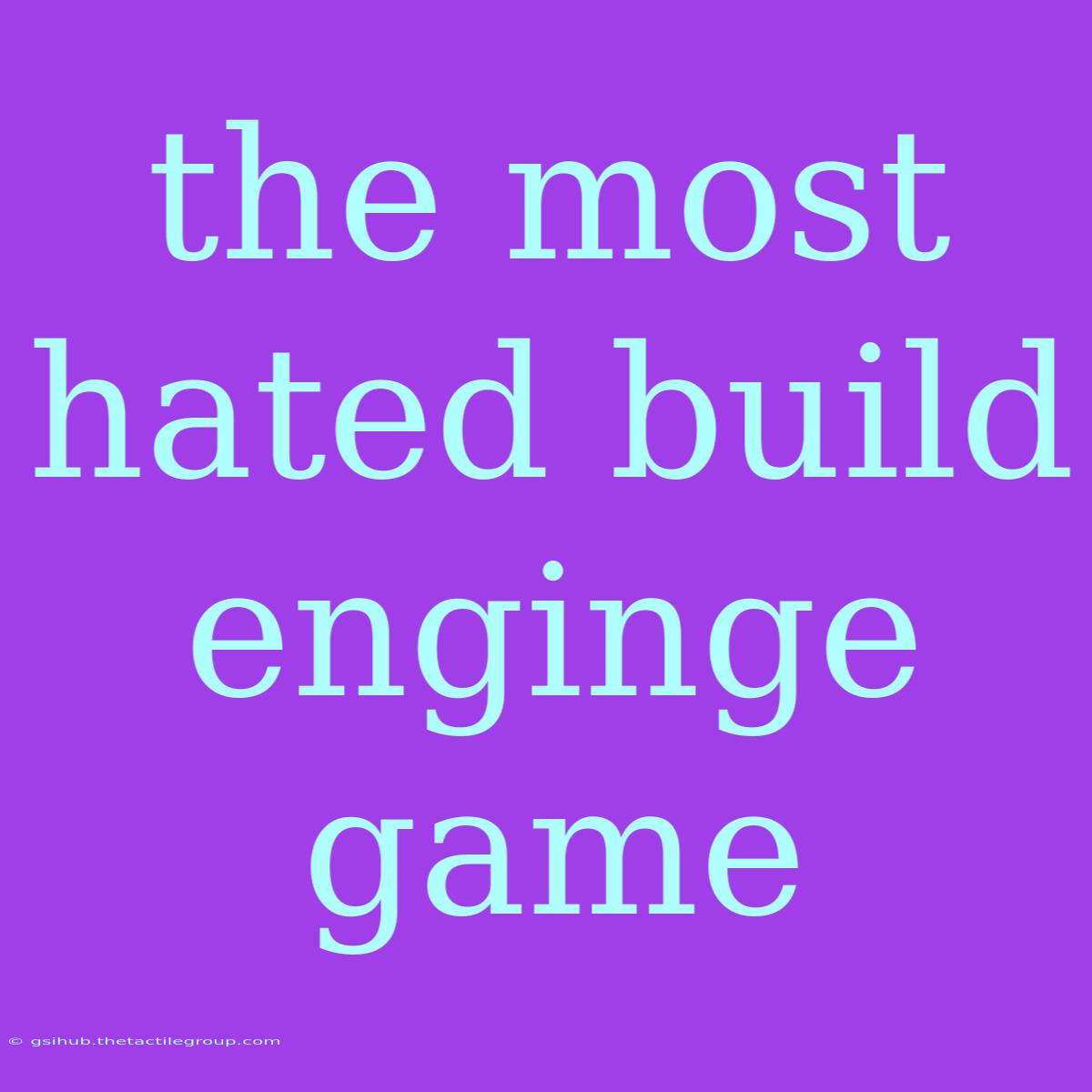The Most Hated Build Engine Games: A Deep Dive into Infamous Titles
Is there a build engine game so notoriously disliked it transcends mere criticism? The answer is a resounding yes, and this exploration delves into the reasons behind their infamous reputations. Editor's Note: This comprehensive guide to notoriously disliked Build engine games has been published today. Understanding these infamous titles offers valuable insights into game design, player expectations, and the evolution of the gaming landscape.
Why This Matters: The Build engine, despite powering iconic games like Duke Nukem 3D, also spawned titles that garnered significant negative attention. Analyzing these failures allows for a critical examination of what makes a game memorable – for better or worse – and provides valuable lessons for developers. This review covers technical aspects, gameplay mechanics, and overall player reception, offering a comprehensive overview of the worst-received Build engine games.
Analysis: This guide meticulously examined player reviews, critical reception, and technical analyses of numerous Build engine games to identify those consistently cited as the most disliked. The analysis focused on identifying recurring issues and common denominators contributing to negative player experiences. The results highlight key factors influencing player perception and offer valuable insights into the qualities that make a game truly successful.
| Key Aspects of Disliked Build Engine Games | Description |
|---|---|
| Poor Level Design | Uninspired, repetitive, or frustrating level layouts. |
| Unbalanced Gameplay | Overly difficult or easy sections, unfair enemy placement. |
| Technical Issues | Bugs, glitches, and performance problems. |
| Weak Story/Narrative | Unengaging or poorly executed storylines. |
| Uninspired Weaponry | Lackluster weapon variety or ineffective weapons. |
Subheading: Poor Level Design
Introduction: Level design is crucial in any Build engine game, influencing the player’s experience directly. A poorly designed level can hinder gameplay, frustrate players, and damage the overall enjoyment. The connection between poor level design and negative reception is undeniable.
Facets:
- Repetitive Environments: Many disliked games featured repetitive level layouts, lacking creativity or visual interest. This monotony led to player fatigue and dissatisfaction.
- Poor Enemy Placement: Unfair or frustrating enemy placement resulted in unfair deaths and impacted player progress. This issue highlights the importance of balanced level design.
- Lack of Exploration: Some games offered little in the way of exploration, limiting player agency and creating a linear experience. This stifled replayability and overall enjoyment.
- Unintuitive Navigation: Poorly designed level navigation systems often confused players and hampered the overall gameplay flow. Clear pathfinding is essential.
Summary: The impact of flawed level design on a Build engine game's reception cannot be overstated. It's a cornerstone upon which player enjoyment is built (or crumbled). Poor level design contributes directly to negative player sentiment and ultimately defines the game's legacy as an infamous title.
Subheading: Unbalanced Gameplay
Introduction: Gameplay balance is essential for a positive player experience. Overly difficult or easy sections can significantly detract from the overall enjoyment and contribute to frustration.
Further Analysis: Consider games where certain weapons are significantly overpowered or underpowered, leading to repetitive or ineffective combat. Similarly, enemy encounters that are either too frequent or too infrequent disrupt the pacing and immersion.
Closing: Striking the right balance in a Build engine game requires careful consideration of many factors, from enemy health to weapon damage to level layout. Failure to achieve this balance can lead to a negative player experience and ultimately contributes to the game's poor reputation.
FAQ
Introduction: This section addresses commonly asked questions about negatively-received Build engine games.
Questions:
- Q: What are some examples of notoriously bad Build engine games? A: Several titles consistently appear on "worst of" lists, but specifics often vary depending on personal preference.
- Q: Why did these games fail? A: Reasons vary but often include poor level design, unbalanced gameplay, and technical issues.
- Q: What lessons can developers learn from these failures? A: The importance of playtesting, balancing, and overall design are highlighted by these failures.
- Q: Did any of these games have redeeming qualities? A: Some may have had niche appeal or interesting elements, but overall flaws overshadowed any positives.
- Q: Are any of these games still played today? A: Some might have cult followings, but their popularity is certainly not mainstream.
- Q: How do these failures compare to other engines? A: While other engines have had their share of failures, the Build engine's reputation is somewhat tarnished by some of its less successful games.
Summary: These questions touch upon various facets of the topic, underlining the complexities and contributing factors behind the negative reception of certain Build engine games.
Tips for Avoiding Build Engine Game Development Pitfalls
Introduction: These tips aim to help developers avoid the common mistakes that lead to negative player experiences with Build engine games.
Tips:
- Thorough Playtesting: Extensive playtesting by a diverse group is crucial.
- Balanced Gameplay: Ensure a fair challenge and avoid frustrating encounters.
- Engaging Level Design: Prioritize creativity, visual interest, and intuitive navigation.
- Compelling Narrative: A well-written story can greatly enhance the experience.
- Technical Optimization: Address bugs and glitches to improve performance.
- Weapon Balance: Ensure weapons are varied and effective without being overpowered.
- Consistent Difficulty: Maintain a consistent level of difficulty throughout the game.
- Clear Objectives: Provide players with clear, concise objectives to follow.
Summary: By implementing these tips, developers can substantially improve the likelihood of creating a well-received and enjoyable Build engine game. Focusing on the player experience is paramount.
Conclusion: A Retrospective on Infamous Titles
Recap: This exploration examined the factors contributing to the negative reputation of certain Build engine games, emphasizing the importance of balanced gameplay, intuitive level design, and technical optimization.
Final Thoughts: The legacy of these games, while predominantly negative, serves as a valuable case study in game development. Understanding what constitutes a poor game experience is as valuable as understanding what creates a positive one. Future developers can benefit from studying these failures and avoiding the same pitfalls.

